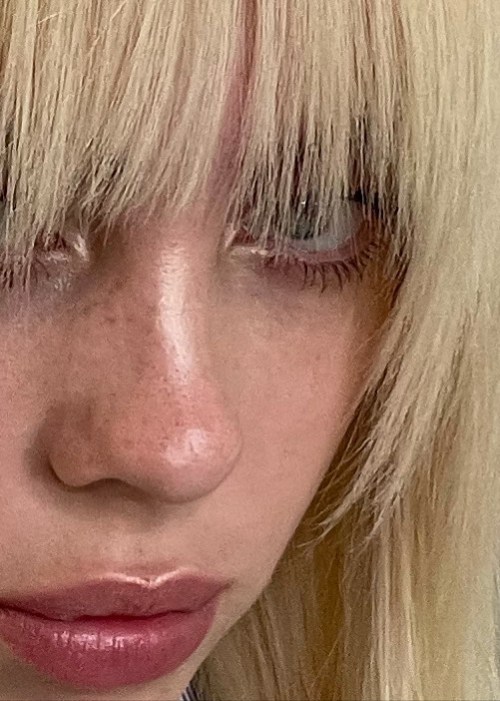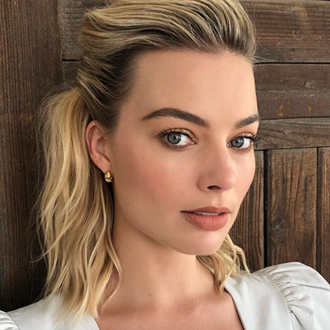How to bleach your hair at home *without* damaging it

Crucial things you should know before taking the plunge
From Kylie Jenner to Kim Kardashian, dramatic hair colour changes have become so popular that it’s now become the norm to see some of your favourite celebs rocking that platinum blonde colour.
While we love soaking up inspo from our favourite celebs, it’s worth noting that when you go from one end of the spectrum (dark) to the other (light), there's actually a whole lot of room for error...and damage. The product you need for the job is bleach and while it’s what the pros use in the salons, it can be very destructive on hair. Even more so if used incorrectly at home.
But, thanks to our favourite A-listers, platinum blonde hair is 'in' and seeing as many of us are short on time and/or money to get it done professionally, DIY hair bleaching is the next best thing. You just gotta know what you’re doing.
“Bleach can damage the hair if the process is not done correctly and the right steps aren’t taken to protect the hair,” says Sydney hairstylist Brad Ngata. “It is important to be realistic about what look you want to achieve by bleaching the hair and the time frame in which you can do this with the least amount of damage,” he adds..
Why bleach your hair?
If you have dark hair and you’re looking to lighten your locks, or go full-on peroxide blonde, or dye it an on-trend shade (think Kylie Jenner’s pastel blue shade, or those grey and silver tones we’re seeing everywhere right now), your hair will need to be bleached first before you can put a lighter tone over the top . Bleaching your hair before colouring helps the hair colour to penetrate deeper into the hair, meaning you’ll get the exact colour you want and the result will actually last longer.
How does hair bleach work?
Hair bleach basically works in the same way as household bleach does to get rid of stains: it removes your hair’s natural pigment by stripping it of the natural melanin or artificial pigment (if you have dyed your hair). While a necessary evil, you can imagine why it takes its toll on your hair “When you bleach your hair, you are effectively removing all colour from your hair, so it is quite a damaging colouring method. It can often cause damage, leaving hair with split ends, dryness and more prone to breakage,” explains Cloud Nine and Evo Creative Director, Lauren McCowan.
“That being said, there are ways that you can reduce the damage done to hair by investing in products that are focused on hydration and repair,” she says.
In order to reduce the risk of damage, prepping your hair and making sure it is in good condition can mean the difference between silky, smooth strands and a fuzzy, damaged mop. You’re going to want to take a few preemptive steps to build up the strength of your hair. You can’t bleach damaged hair (well, you can, but it won’t look good), so its pays to invest in some conditioning hair masks and hydrating treatments.
“Bleach essentially strips the hair of moisture, so I would always recommend regular deep hydrating masks for anyone that bleaches their hair or is looking to do so,” says Ngata. “De Lorenzo’s Essential Treatments Equilibrium ($28.50 at De Lorenzo) is a great option that anyone can use at home, both overnight or in the shower, that helps restore and repair the hair.”
What tools and products do you need to bleach your own hair?
Before we get on to how to bleach hair, knowing what kind of bleaching hair products and tools to have in your kit is incredibly important and can make a big difference in reaching your desired results and limiting the risk of damage.
First up, you need a bleach powder, such as HI LIFT Blue Bleach ($18.99 at Priceline) McCowan says, “Invest in a good quality one, as compromising on this could yield disastrous results! I would recommend one that is blue or purple in colour as it will reduce brassiness.”
You’ll also need a developer/peroxide liquid, which is mixed with the powder to activate the bleach. We recommend trying Innovative Crème Developer Activator ($10.99 at Priceline). McCowan notes that the strength of the developer will determine the amount of lift you’ll get. “[Developers] come in different strengths depending on your hair needs, so ask a professional hairdresser if you are unsure which one is right for you.”
“You will also need a tinting brush, latex gloves, sectioning clips, cling wrap and a mixing bowl.”
How to bleach hair at home
Learning how to bleach your hair is no easy feat, and there are some specific steps you need to take to avoid sacrificing the health of your hair (and burning your scalp). But once you know the basic rules on how to do it responsibly, that platinum blonde colour will be totally worth it.
Follow these five expert-approved steps to bleach hair at home without damage.
1 / Section your hair
Divide your hair in sections, with the crown area secured away. “This will allow you to work freely on the back of your hair first,” says McCowan.
2 / Mix the bleach and developer
Put on some gloves and mix the bleach and developer as per the instructions on the bottles, ensuring there are no lumps.
3 / Apply the bleach
McCowan says, “Apply the bleach with a tinting brush, starting with the bottom sections and working your way to the top of your head. Once all hair is covered in bleach, cover with cling wrap.”
4/ Wait it out
“Leave the bleach on for about 30-45 minutes, checking periodically to see if the colour is lifting to the levels you want,” says McCowan.
5 / Wash your hair
When you’re happy with the level of colour lift, hop in the shower and make sure you rinse the bleach out of your hair thoroughly. Follow with a good hydrating and repairing conditioner. Remember to stay away from heat tools and allow your hair to dry naturally to minimise the risk of damage.
If heat is required, McCowan suggests investing in tools with temperature control settings. “I love the entire Cloud Nine range as they all have this feature, allowing you to use a lower heat to style. I absolutely love the Airshot Hairdryer (was $240 now $200 at Cloud Nine) as it also helps to tame frizz whilst drying your hair.”
After bleaching your hair, it’s important to incorporate repairing products into your routine, such as OGX Renewing Moroccan Argan Oil Shampoo and Conditioner ($9.99 at Chemist Warehouse). McCowan also recommends using a hair mask at least once a week to help repair and strengthen your hair after bleaching it. “It is also imperative to incorporate a toning product into your routine to stop your hair from turning brassy,” says McCowan. “Evo’s Platinum Blonde Fabuloso Colour Boosting Treatment ($39.95 at Adore Beauty) keeps yellow tones at bay, and works to nourish, condition, repair and enhance shine.”
Tossing up whether or not to take the platinum blonde plunge? Check out these famous redheads who have dabbled with blonde (and vice versa).
Main image credit: @billieeilish

Erin Docherty is a Beauty Writer for BEAUTYcrew, Beauty Editor for Women's Health magazine and a Grooming Writer for Men's Health magazine. She has a keen interest in cosmeceutical skin care and is currently working on minimising her 9-step skin care routine – because ain’t nobody got time for that. When she’s not writing about the latest beauty news, or applying copious amounts of serum, you can find her spending all her money in Sephora.







